TESLA MODEL S 2015 クイックガイド (in Japanese)
Manufacturer: TESLA, Model Year: 2015, Model line: MODEL S, Model: TESLA MODEL S 2015Pages: 96, PDF Size: 2.86 MB
Page 31 of 96
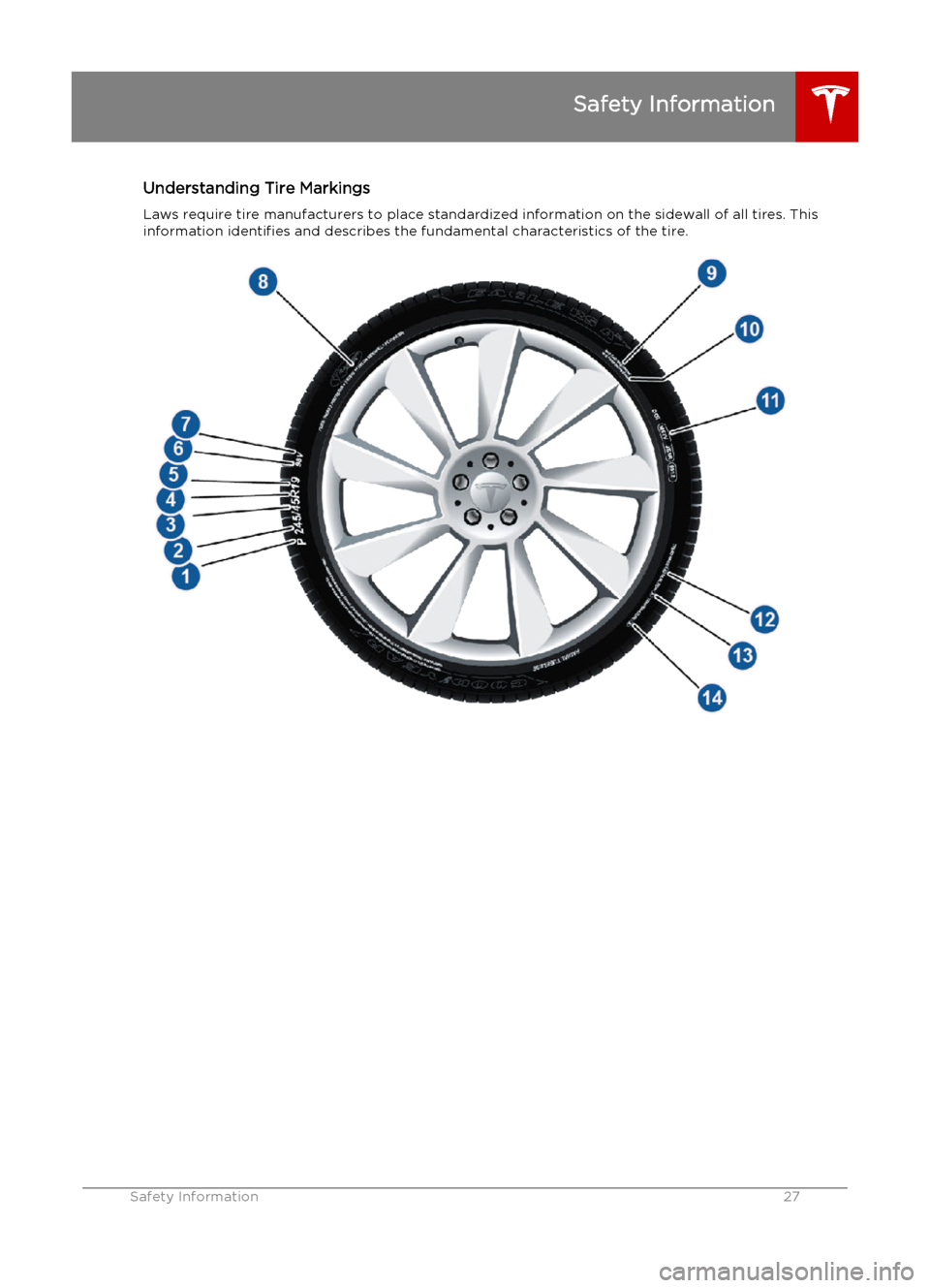
Understanding Tire MarkingsLaws require tire manufacturers to place standardized information on the sidewall of all tires. Thisinformation identifies and describes the fundamental characteristics of the tire.
Safety Information
Safety Information27
Page 32 of 96
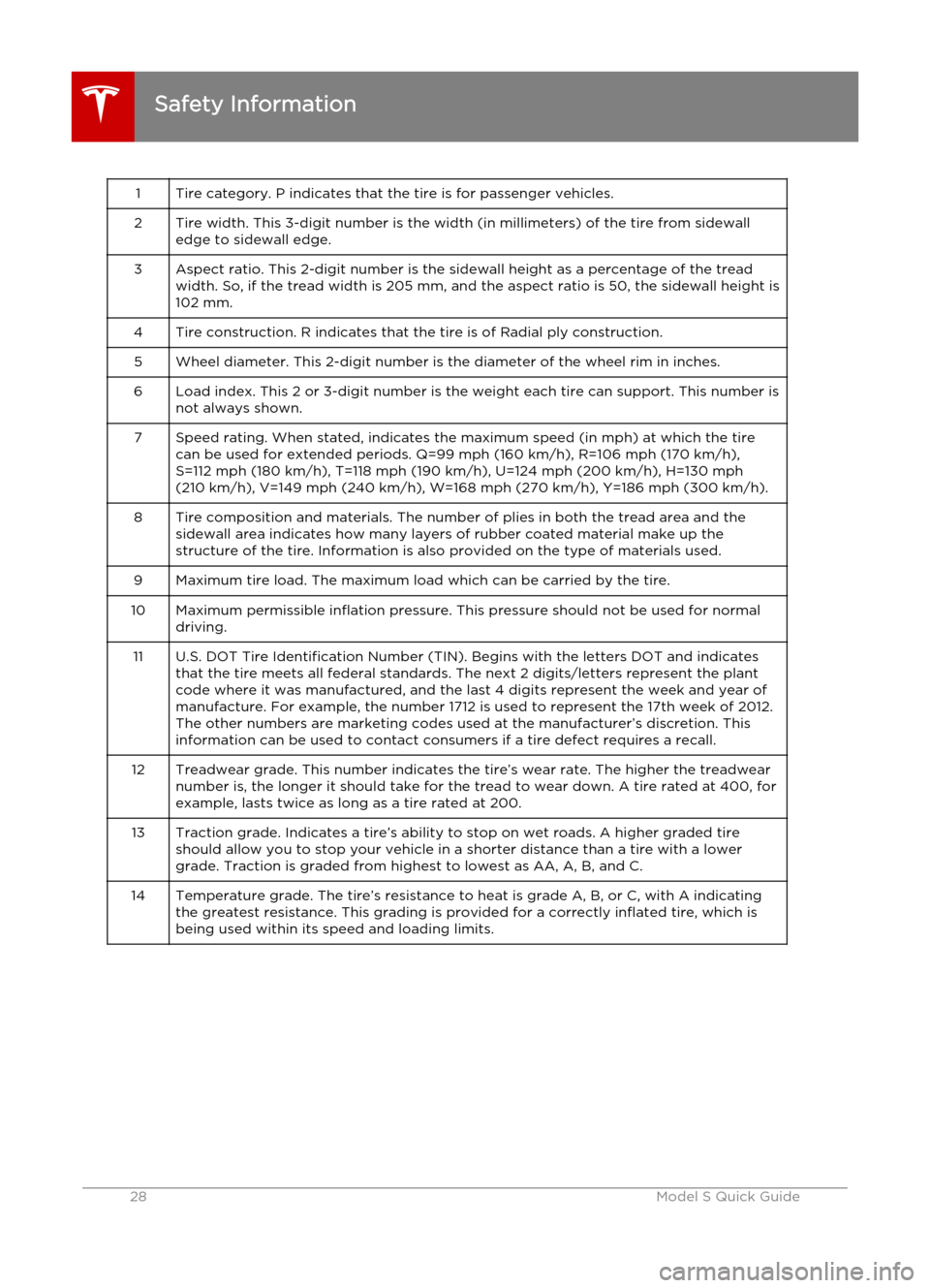
1Tire category. P indicates that the tire is for passenger vehicles.2Tire width. This 3-digit number is the width (in millimeters) of the tire from sidewall
edge to sidewall edge.3Aspect ratio. This 2-digit number is the sidewall height as a percentage of the tread width. So, if the tread width is 205 mm, and the aspect ratio is 50, the sidewall height is
102 mm.4Tire construction. R indicates that the tire is of Radial ply construction.5Wheel diameter. This 2-digit number is the diameter of the wheel rim in inches.6Load index. This 2 or 3-digit number is the weight each tire can support. This number is not always shown.7Speed rating. When stated, indicates the maximum speed (in mph) at which the tire
can be used for extended periods. Q=99 mph (160 km/h), R=106 mph (170 km/h),
S=112 mph (180 km/h), T=118 mph (190 km/h), U=124 mph (200 km/h), H=130 mph
(210 km/h), V=149 mph (240 km/h), W=168 mph (270 km/h), Y=186 mph (300 km/h).8Tire composition and materials. The number of plies in both the tread area and the sidewall area indicates how many layers of rubber coated material make up the
structure of the tire. Information is also provided on the type of materials used.9Maximum tire load. The maximum load which can be carried by the tire.10Maximum permissible inflation pressure. This pressure should not be used for normal driving.11U.S. DOT Tire Identification Number (TIN). Begins with the letters DOT and indicates
that the tire meets all federal standards. The next 2 digits/letters represent the plant
code where it was manufactured, and the last 4 digits represent the week and year of
manufacture. For example, the number 1712 is used to represent the 17th week of 2012.
The other numbers are marketing codes used at the manufacturer’s discretion. This
information can be used to contact consumers if a tire defect requires a recall.12Treadwear grade. This number indicates the tire’s wear rate. The higher the treadwear number is, the longer it should take for the tread to wear down. A tire rated at 400, for
example, lasts twice as long as a tire rated at 200.13Traction grade. Indicates a tire’s ability to stop on wet roads. A higher graded tire should allow you to stop your vehicle in a shorter distance than a tire with a lower
grade. Traction is graded from highest to lowest as AA, A, B, and C.14Temperature grade. The tire’s resistance to heat is grade A, B, or C, with A indicating
the greatest resistance. This grading is provided for a correctly inflated tire, which is
being used within its speed and loading limits.
Safety Information
28Model S Quick Guide
Page 33 of 96
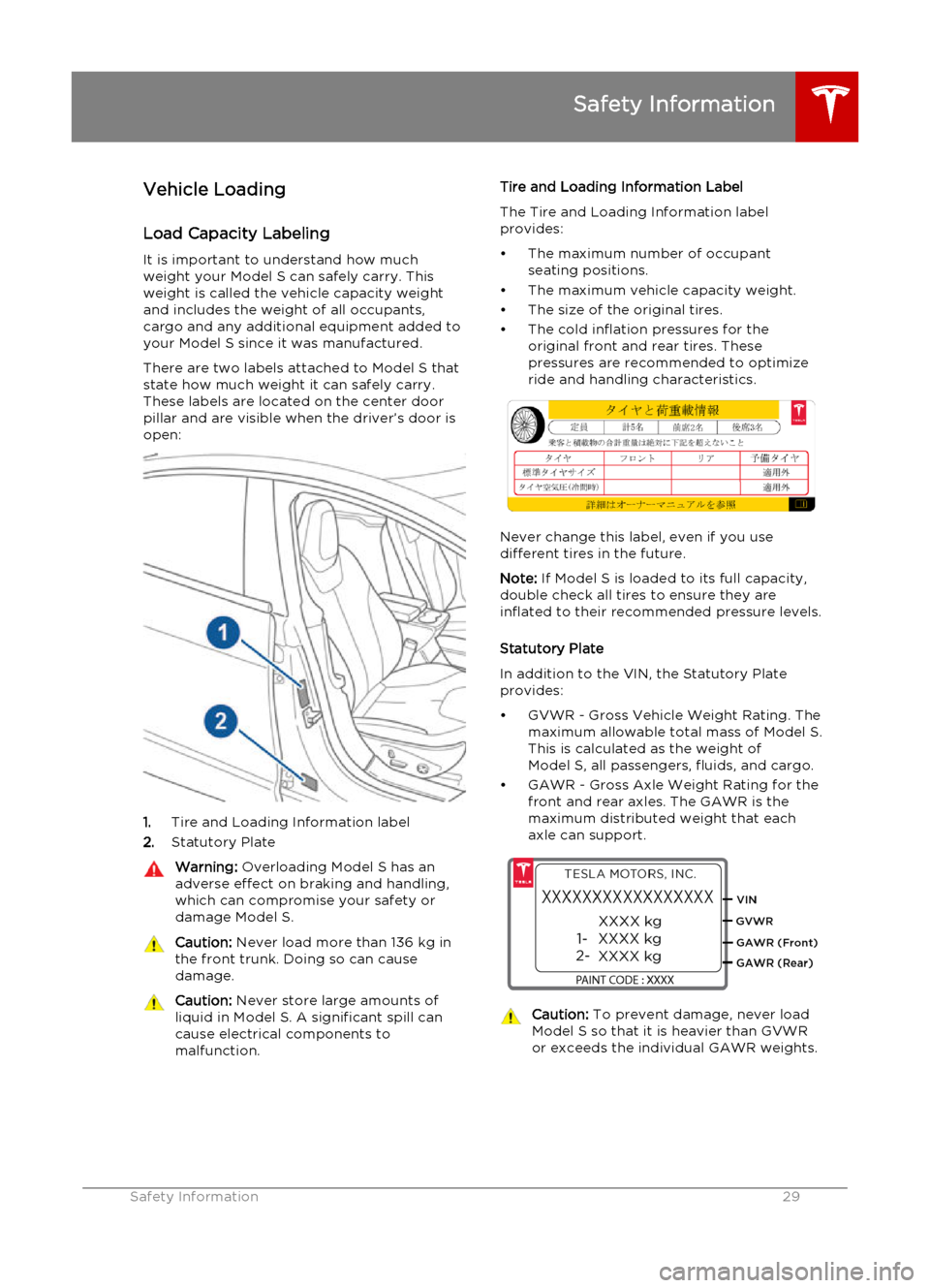
Vehicle Loading
Load Capacity Labeling It is important to understand how much
weight your Model S can safely carry. This weight is called the vehicle capacity weight
and includes the weight of all occupants, cargo and any additional equipment added toyour Model S since it was manufactured.
There are two labels attached to Model S that
state how much weight it can safely carry.
These labels are located on the center door
pillar and are visible when the driver’s door is
open:
1. Tire and Loading Information label
2. Statutory Plate
Warning:
Overloading Model S has an
adverse effect on braking and handling,
which can compromise your safety or
damage Model S.Caution: Never load more than 136 kg in
the front trunk. Doing so can cause
damage.Caution: Never store large amounts of
liquid in Model S. A significant spill can
cause electrical components to
malfunction.Tire and Loading Information Label
The Tire and Loading Information label provides:
• The maximum number of occupant seating positions.
• The maximum vehicle capacity weight.
• The size of the original tires.
• The cold inflation pressures for the original front and rear tires. These
pressures are recommended to optimize
ride and handling characteristics.
Never change this label, even if you use different tires in the future.
Note: If Model S is loaded to its full capacity,
double check all tires to ensure they are
inflated to their recommended pressure levels.
Statutory Plate
In addition to the VIN, the Statutory Plate provides:
• GVWR - Gross Vehicle Weight Rating. The maximum allowable total mass of Model S.
This is calculated as the weight of
Model S, all passengers, fluids, and cargo.
• GAWR - Gross Axle Weight Rating for the front and rear axles. The GAWR is the
maximum distributed weight that each
axle can support.
Caution: To prevent damage, never load
Model S so that it is heavier than GVWR
or exceeds the individual GAWR weights.
Safety Information
Safety Information29
Page 34 of 96
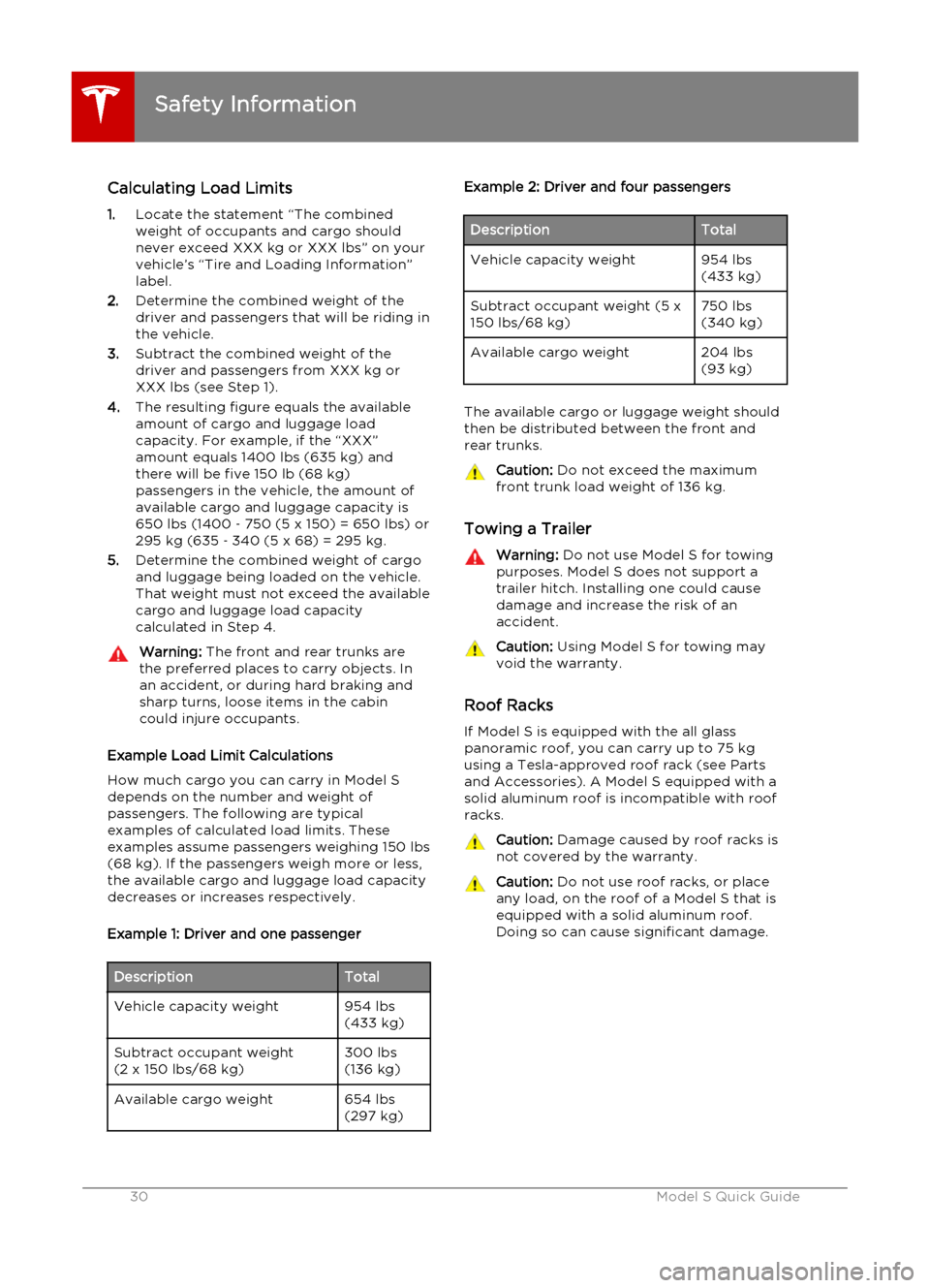
Calculating Load Limits
1. Locate the statement “The combined
weight of occupants and cargo should never exceed XXX kg or XXX lbs” on your
vehicle’s “Tire and Loading Information” label.
2. Determine the combined weight of the
driver and passengers that will be riding in
the vehicle.
3. Subtract the combined weight of the
driver and passengers from XXX kg or
XXX lbs (see Step 1).
4. The resulting figure equals the available
amount of cargo and luggage load
capacity. For example, if the “XXX”
amount equals 1400 lbs (635 kg) and there will be five 150 lb (68 kg)
passengers in the vehicle, the amount of
available cargo and luggage capacity is
650 lbs (1400 ‑ 750 (5 x 150) = 650 lbs) or
295 kg (635 ‑ 340 (5 x 68) = 295 kg.
5. Determine the combined weight of cargo
and luggage being loaded on the vehicle.
That weight must not exceed the available
cargo and luggage load capacity
calculated in Step 4.Warning: The front and rear trunks are
the preferred places to carry objects. In
an accident, or during hard braking and sharp turns, loose items in the cabin
could injure occupants.
Example Load Limit Calculations
How much cargo you can carry in Model S
depends on the number and weight of
passengers. The following are typical
examples of calculated load limits. These
examples assume passengers weighing 150 lbs (68 kg). If the passengers weigh more or less,
the available cargo and luggage load capacity decreases or increases respectively.
Example 1: Driver and one passenger
DescriptionTotalVehicle capacity weight954 lbs
(433 kg)Subtract occupant weight
(2 x 150 lbs/68 kg)300 lbs
(136 kg)Available cargo weight654 lbs
(297 kg)Example 2: Driver and four passengersDescriptionTotalVehicle capacity weight954 lbs
(433 kg)Subtract occupant weight (5 x
150 lbs/68 kg)750 lbs
(340 kg)Available cargo weight204 lbs
(93 kg)
The available cargo or luggage weight should
then be distributed between the front and
rear trunks.
Caution: Do not exceed the maximum
front trunk load weight of 136 kg.
Towing a Trailer
Warning: Do not use Model S for towing
purposes. Model S does not support a
trailer hitch. Installing one could cause
damage and increase the risk of an
accident.Caution: Using Model S for towing may
void the warranty.
Roof Racks
If Model S is equipped with the all glasspanoramic roof, you can carry up to 75 kgusing a Tesla-approved roof rack (see Partsand Accessories). A Model S equipped with a
solid aluminum roof is incompatible with roof
racks.
Caution: Damage caused by roof racks is
not covered by the warranty.Caution: Do not use roof racks, or place
any load, on the roof of a Model S that is equipped with a solid aluminum roof.Doing so can cause significant damage.
Safety Information
30Model S Quick Guide
Page 35 of 96

DisclaimersVehicle Telematics/Data RecordersThis vehicle is equipped with electronic
modules that monitor and record data from
various vehicle systems, including the motor,
Battery, braking and electrical systems. The
electronic modules record information about
various driving and vehicle conditions,
including braking, acceleration, trip and other
related information regarding your vehicle.
These modules also record information about
the vehicle’s features such as charging events
and status, the enabling/disabling of various
systems, diagnostic trouble codes, VIN, speed,
direction and location.
The data is stored by the vehicle and may be
accessed, used and stored by Tesla service
technicians during vehicle servicing or
periodically transmitted to Tesla wirelessly
through the vehicle’s telematics system. This
data may be used by Tesla for various
purposes, including, but not limited to:
providing you with Tesla telematics services;
troubleshooting; evaluation of your vehicle’s
quality, functionality and performance;
analysis and research by Tesla and its partners
for the improvement and design of our
vehicles and systems; and as otherwise may
be required by law. In servicing your vehicle,
we can potentially resolve issues remotely
simply by reviewing your vehicle’s data log.
Tesla’s telematics system wirelessly transmits
vehicle information to Tesla on a periodic
basis. The data is used as described above and helps ensure the proper maintenance of
your vehicle. Additional Model S features may
use your vehicle’s telematics system and the
information provided, including features such
as charging reminders, software updates, and
remote access to, and control of, various
systems of your vehicle.
Tesla does not disclose the data recorded in
your vehicle to any third party except when:
• An agreement or consent from the vehicle’s owner (or the leasing companyfor a leased vehicle) is obtained.
• Officially requested by the police or other authorities.
• Used as a defense for Tesla in a lawsuit. • Ordered by a court of law.• Used for research purposes without disclosing details of the vehicle owner or
identification information.
• Disclosed to a Tesla affiliated company, including their successors or assigns, or
our information systems and data
management providers.
In addition, Tesla does not disclose the data
recorded to an owner unless it pertains to a
non-warranty repair service and in this case,
will disclose only the data that is related to the repair.
Quality Control You might notice a few km on the odometer
when you take delivery of your Model S. This is a result of a comprehensive testing process
that ensures the quality of your Model S.
The testing process includes extensive
inspections during and after production. The final inspection takes place at Tesla Motors
and includes a road test conducted by a
technician.
Safety Information
Safety Information31
Page 36 of 96
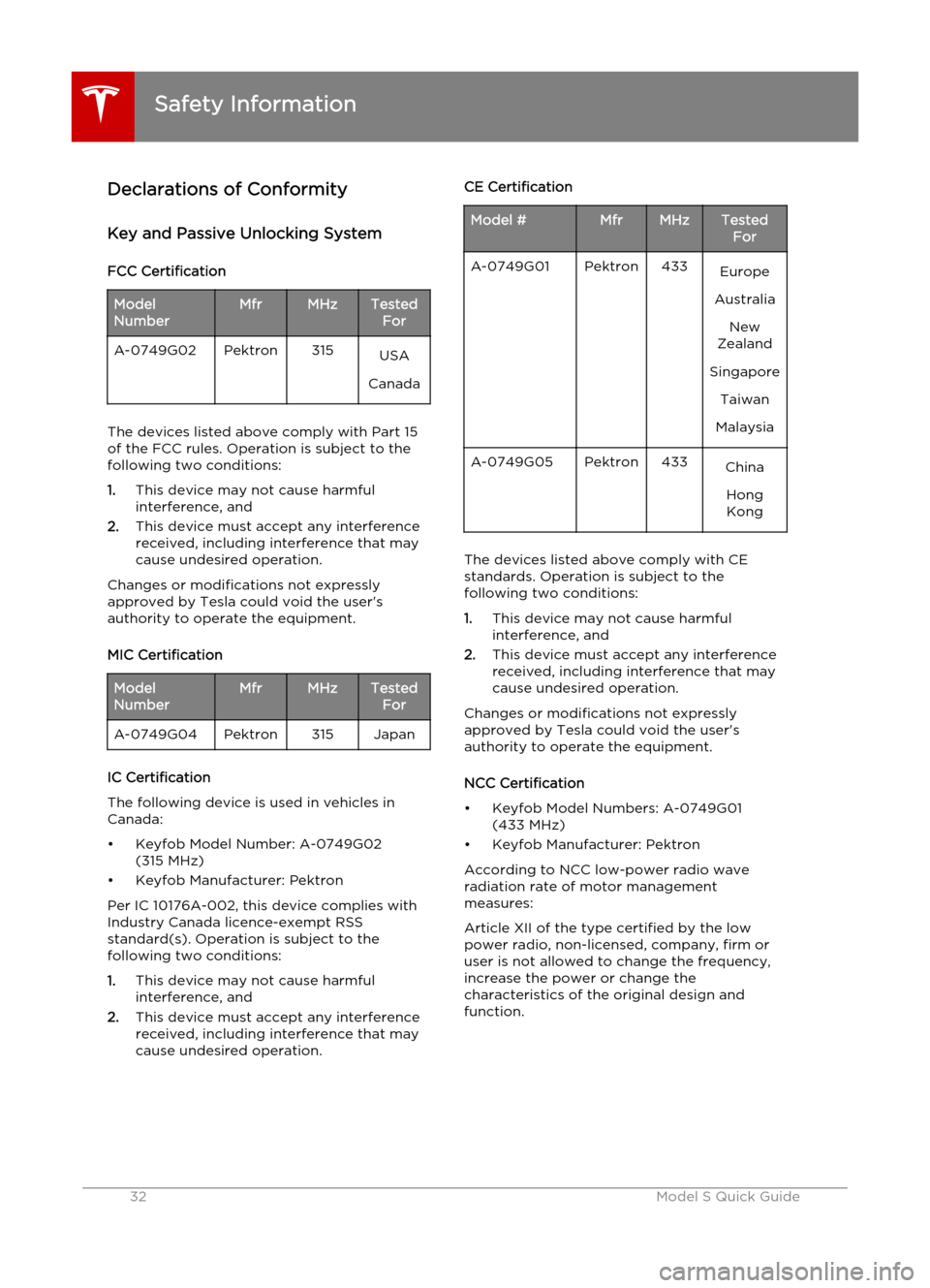
Declarations of Conformity
Key and Passive Unlocking System
FCC CertificationModel
NumberMfrMHzTested ForA-0749G02Pektron315USA
Canada
The devices listed above comply with Part 15
of the FCC rules. Operation is subject to the
following two conditions:
1. This device may not cause harmful
interference, and
2. This device must accept any interference
received, including interference that may
cause undesired operation.
Changes or modifications not expressly
approved by Tesla could void the user's
authority to operate the equipment.
MIC Certification
Model
NumberMfrMHzTested ForA-0749G04Pektron315Japan
IC Certification
The following device is used in vehicles in
Canada:
• Keyfob Model Number: A-0749G02 (315 MHz)
• Keyfob Manufacturer: Pektron
Per IC 10176A-002, this device complies with
Industry Canada licence-exempt RSS standard(s). Operation is subject to thefollowing two conditions:
1. This device may not cause harmful
interference, and
2. This device must accept any interference
received, including interference that may
cause undesired operation.
CE CertificationModel #MfrMHzTested ForA-0749G01Pektron433Europe
Australia New
Zealand
Singapore Taiwan
MalaysiaA-0749G05Pektron433China
HongKong
The devices listed above comply with CEstandards. Operation is subject to thefollowing two conditions:
1. This device may not cause harmful
interference, and
2. This device must accept any interference
received, including interference that may
cause undesired operation.
Changes or modifications not expressly
approved by Tesla could void the user's authority to operate the equipment.
NCC Certification
• Keyfob Model Numbers: A-0749G01 (433 MHz)
• Keyfob Manufacturer: Pektron
According to NCC low-power radio wave
radiation rate of motor management measures:
Article XII of the type certified by the low
power radio, non-licensed, company, firm or
user is not allowed to change the frequency,
increase the power or change the
characteristics of the original design and
function.
Safety Information
32Model S Quick Guide
Page 37 of 96
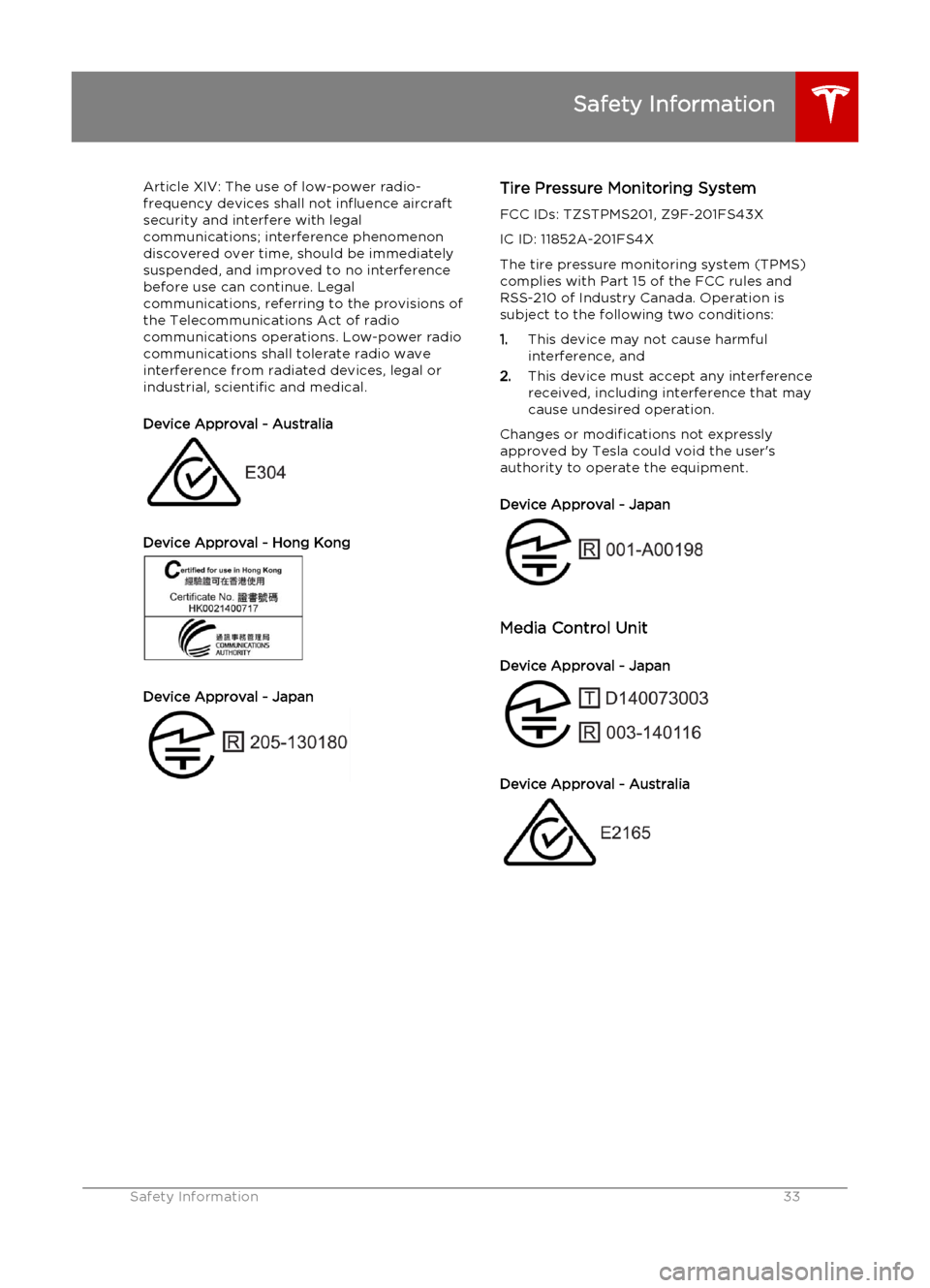
Article XIV: The use of low-power radio-
frequency devices shall not influence aircraft security and interfere with legal
communications; interference phenomenon
discovered over time, should be immediately suspended, and improved to no interference
before use can continue. Legal
communications, referring to the provisions of
the Telecommunications Act of radio communications operations. Low-power radiocommunications shall tolerate radio wave
interference from radiated devices, legal or
industrial, scientific and medical.
Device Approval - Australia
Device Approval - Hong Kong
Device Approval - Japan
Tire Pressure Monitoring System
FCC IDs: TZSTPMS201, Z9F-201FS43X IC ID: 11852A-201FS4X
The tire pressure monitoring system (TPMS)
complies with Part 15 of the FCC rules and
RSS-210 of Industry Canada. Operation is subject to the following two conditions:
1. This device may not cause harmful
interference, and
2. This device must accept any interference
received, including interference that may
cause undesired operation.
Changes or modifications not expressly
approved by Tesla could void the user's authority to operate the equipment.
Device Approval - Japan
Media Control Unit
Device Approval - Japan
Device Approval - Australia
Safety Information
Safety Information33
Page 38 of 96

Radio Frequency InformationThis equipment has been tested and found to
comply with the limits for a Class B digital device, pursuant to Part 15 of the FCC Rules.These limits are designed to provide
reasonable protection against harmful interference in a residential installation. This
equipment generates, uses and can radiate
radio frequency energy and, if not installed
and used in accordance with the instructions, may cause harmful interference to radio
communications. However, there is no
guarantee that interference will not occur in a
particular installation. If this equipment does cause harmful interference to radio or
television reception, which can be determined
by turning the equipment off and on, the user
is encouraged to try to correct the
interference by one or more of the following
measures:
• Reorient or relocate the receiving antenna.
• Increase the separation between the equipment and receiver.
• Connect the equipment into an outlet on a circuit different from that to which the
receiver is connected.
• Consult the dealer or an experienced radio/TV technician for help.
Safety Information
34Model S Quick Guide
Page 39 of 96
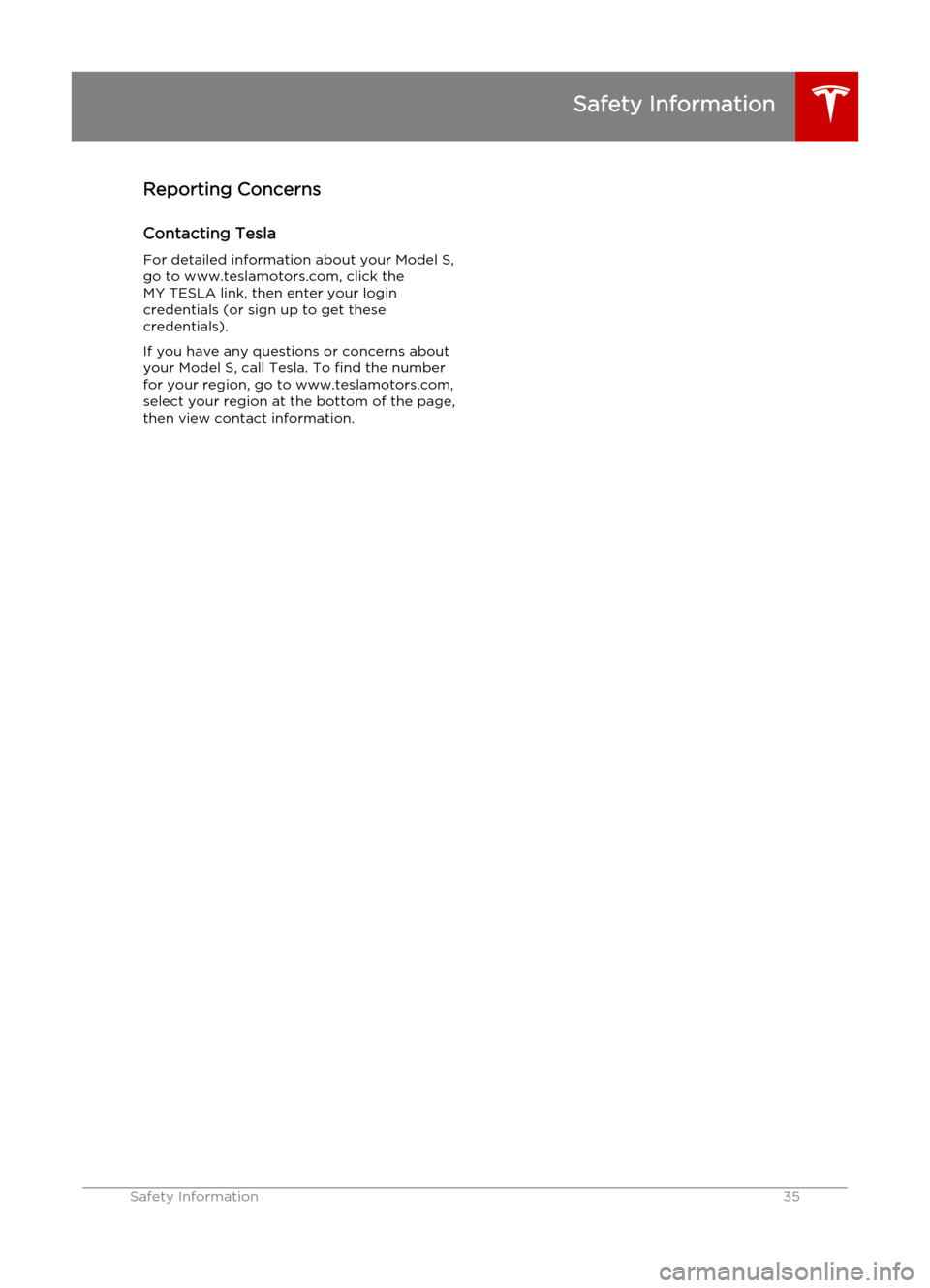
Reporting Concerns
Contacting Tesla For detailed information about your Model S,
go to www.teslamotors.com, click the
MY TESLA link, then enter your login
credentials (or sign up to get these
credentials).
If you have any questions or concerns about your Model S, call Tesla. To find the number
for your region, go to www.teslamotors.com,
select your region at the bottom of the page,
then view contact information.
Safety Information
Safety Information35
Page 40 of 96
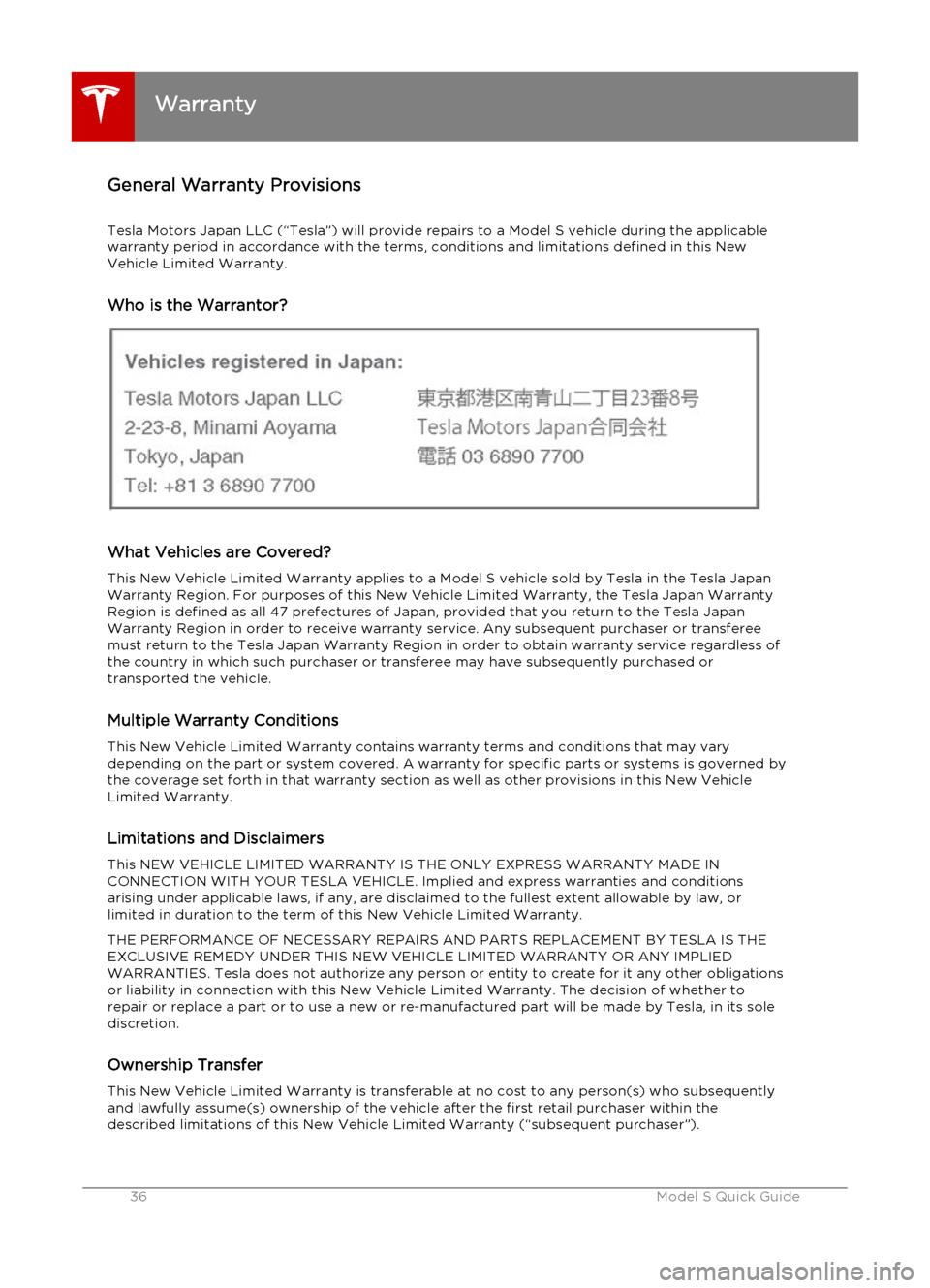
General Warranty ProvisionsTesla Motors Japan LLC (“Tesla”) will provide repairs to a Model S vehicle during the applicablewarranty period in accordance with the terms, conditions and limitations defined in this New
Vehicle Limited Warranty.
Who is the Warrantor?
What Vehicles are Covered?
This New Vehicle Limited Warranty applies to a Model S vehicle sold by Tesla in the Tesla Japan Warranty Region. For purposes of this New Vehicle Limited Warranty, the Tesla Japan Warranty
Region is defined as all 47 prefectures of Japan, provided that you return to the Tesla Japan
Warranty Region in order to receive warranty service. Any subsequent purchaser or transferee
must return to the Tesla Japan Warranty Region in order to obtain warranty service regardless of
the country in which such purchaser or transferee may have subsequently purchased or
transported the vehicle.
Multiple Warranty Conditions
This New Vehicle Limited Warranty contains warranty terms and conditions that may vary
depending on the part or system covered. A warranty for specific parts or systems is governed by
the coverage set forth in that warranty section as well as other provisions in this New Vehicle
Limited Warranty.
Limitations and Disclaimers This NEW VEHICLE LIMITED WARRANTY IS THE ONLY EXPRESS WARRANTY MADE INCONNECTION WITH YOUR TESLA VEHICLE. Implied and express warranties and conditions
arising under applicable laws, if any, are disclaimed to the fullest extent allowable by law, or limited in duration to the term of this New Vehicle Limited Warranty.
THE PERFORMANCE OF NECESSARY REPAIRS AND PARTS REPLACEMENT BY TESLA IS THE EXCLUSIVE REMEDY UNDER THIS NEW VEHICLE LIMITED WARRANTY OR ANY IMPLIEDWARRANTIES. Tesla does not authorize any person or entity to create for it any other obligationsor liability in connection with this New Vehicle Limited Warranty. The decision of whether to
repair or replace a part or to use a new or re-manufactured part will be made by Tesla, in its sole discretion.
Ownership Transfer
This New Vehicle Limited Warranty is transferable at no cost to any person(s) who subsequently
and lawfully assume(s) ownership of the vehicle after the first retail purchaser within the
described limitations of this New Vehicle Limited Warranty (“subsequent purchaser”).
Warranty
36Model S Quick Guide